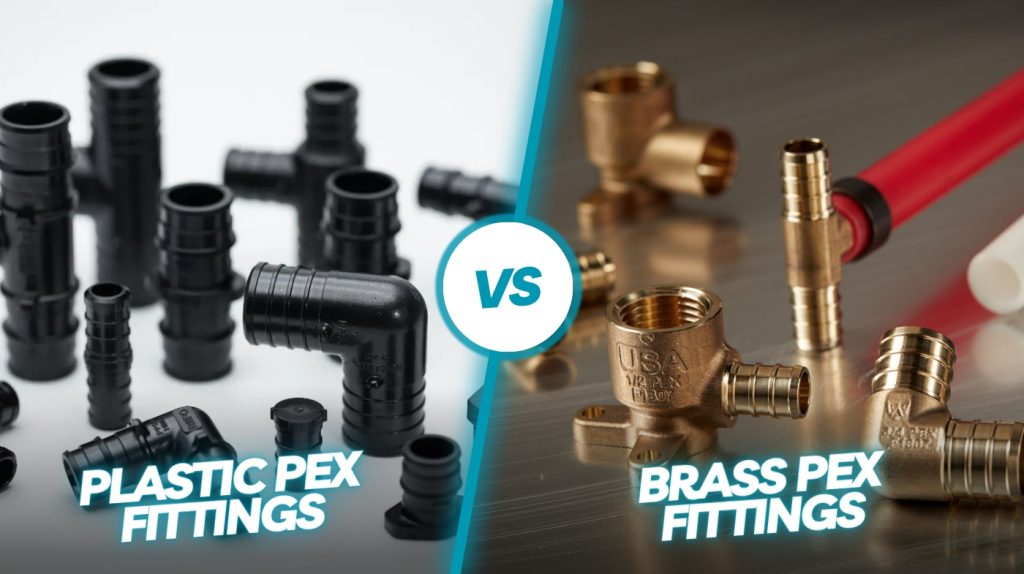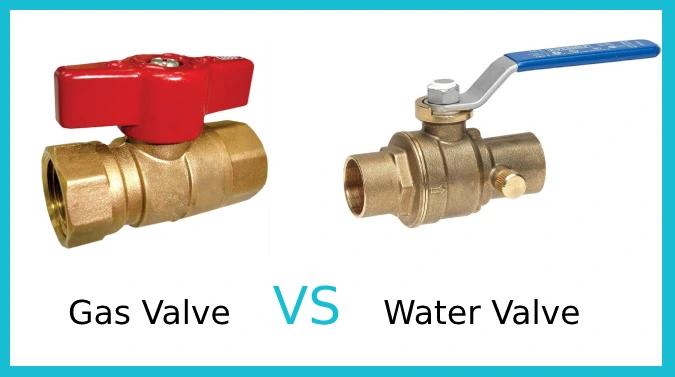Last Updated on May 4, 2025
When choosing between plastic and brass PEX fittings, consider durability, corrosion resistance, and flow impact. Plastic fittings are lightweight, easier to install, and cost less but have smaller internal diameters that may reduce flow and are prone to cracking.
Brass fittings offer superior strength, corrosion resistance, and maintain better flow performance under pressure but cost more upfront. Your choice depends on application environment and budget exploring each option reveals critical trade-offs affecting system longevity and efficiency.
Key Takeaways
- Brass fittings offer superior durability and pressure resistance, ideal for high-pressure or exposed plumbing environments.
- Plastic fittings are lightweight, cost-effective, and enable faster installation with push-fit connections but have smaller internal diameters.
- Brass fittings maintain larger internal diameters, reducing flow restrictions and turbulence compared to thicker-walled plastic fittings.
- Plastic fittings resist chemical corrosion and maintain neutral water quality, while brass may leach metals affecting taste and safety.
- Despite higher upfront costs, brass fittings provide better long-term value due to reduced maintenance and stronger mechanical connections.
Material Composition and Durability Comparison
While both plastic and brass PEX fittings serve as essential components in plumbing systems, their material composition greatly influences their durability and performance.
Plastic fittings, molded from durable polymers, offer lightweight, cost-effective solutions compatible with PEX pipes. Brass fittings, machined from a copper-zinc alloy, feature increased material thickness, enhancing strength and longevity.
You’ll find brass fittings excel in high-pressure and high-temperature environments due to their superior mechanical properties and reduced thermal expansion compared to plastic.
Although plastic fittings provide ease of installation with push-fit connections, brass fittings accommodate both crimp-ring and push-fit methods, catering to diverse applications. Their heavier weight reflects this robustness.
Additionally, PEX pipes themselves have a high strength and toughness that complement the durability of both fitting types. Brass fittings deliver extended lifespan and durability, justifying their higher initial cost, especially for demanding commercial or high-pressure installations.
Corrosion Resistance and Water Quality Considerations
Brass and plastic PEX fittings differ not only in strength and installation methods but also in how they respond to corrosion and affect water quality.
Brass offers superior inherent corrosion resistance due to its metallic nature but can degrade in high-salinity or aggressive chemical environments, potentially releasing metallic contaminants that alter water taste and safety.
Proper installation and regular inspections are vital to prevent corrosion-related leaks and maintain system integrity. Brass resists corrosion well but may release metals in harsh environments, affecting water taste and safety.
Plastic fittings resist chemical corrosion better and generally maintain neutral water quality, with minimal risk of leaching harmful substances. However, PEX pipes themselves have been shown in studies to leach contaminants that may affect water quality.
Both require protective measures under harsh conditions to preserve system integrity and prevent scaling, which compromises flow and necessitates maintenance.
Ensuring fittings meet safety certifications, like NSF, and conducting regular inspections helps mitigate contamination risks. Your choice must balance environmental exposure, longevity, and water quality impact to optimize system performance and safety.
Impact on Flow Rate and Hydraulic Performance
Because plastic PEX fittings have thicker walls per ASTM F2159 standards, their internal diameter (ID) is smaller than that of brass fittings, which directly reduces flow capacity.
You’ll notice this causes increased pressure drops, especially in systems featuring multiple fittings or 90-degree elbows, where turbulence heightens friction loss.
Brass fittings maintain a larger ID and smoother internal geometry, minimizing turbulence and preserving hydraulic efficiency. Additionally, brass withstands high pressures better, ensuring stable flow under peak demand and transient conditions like water hammer.
Plastic fittings, while flexible and resistant to scale buildup, can compound flow restrictions in complex systems, reducing downstream pressure and flow reliability. They are also lighter and less expensive, requiring fewer supports, which can be advantageous in certain installation scenarios cost-effectiveness.
If you prioritize ideal hydraulic performance and sustained flow rates, especially in commercial or high-pressure applications, brass fittings generally outperform plastic counterparts due to superior internal design and material rigidity.
Cost Analysis and Long-Term Value
Understanding the hydraulic advantages of brass fittings naturally leads to contemplating their financial implications over time. Brass fittings cost about five times more per unit than plastic. However, their superior durability and resistance to pressure can reduce long-term maintenance.
Additionally, brass fittings provide a stronger mechanical connection due to their material strength compared to plastic options. Plastic fittings are budget-friendly but prone to cracking, increasing replacement frequency.
Here’s a concise cost and value comparison:
| Aspect | Brass Fittings | Plastic Fittings |
|---|---|---|
| Initial Cost | High (~5x unit price) | Low |
| Durability | Superior; withstands stress & heat | Moderate; prone to cracking |
| Maintenance | Lower; fewer repairs needed | Higher; more frequent replacement |
| Long-Term Value | Strong; offsets initial cost | Cost-effective upfront, less durable |
Installation Practices and Application Suitability
When installing PEX fittings, the choice between plastic and brass considerably influences your required tools and techniques.
Plastic fittings often allow quicker installations with simpler tools, such as crimp rings or expansion tools, but demand precise timing for expansion fittings. Ensure square cuts on PEX for proper fitting and to prevent leaks.
Additionally, plastic fittings are sensitive to UV exposure and should be used in protected environments to maintain longevity. Brass fittings require specific crimp or clamp tools and careful handling to avoid overtightening or damaging tubing.
Their metal construction provides superior resistance to mechanical stress and extreme temperatures, making them ideal for more demanding plumbing scenarios.
Application suitability also varies; plastic fittings suit indoor, corrosion-free environments, while brass excels in harsh, high-pressure, or exposed conditions due to durability and antimicrobial properties.
- Plastic fittings need burr-free, square cuts and timely expansion insertion
- Brass fittings rely on metal stops for insertion depth control and precise crimping
- Plastic suits potable water and radiant heating with flexibility benefits
- Brass withstands extreme temperatures, pressures, and mechanical stress better
Frequently Asked Questions
Which Fitting Type Is More Environmentally Friendly to Manufacture and Dispose Of?
You’ll find manufacturing plastic fittings uses less energy and emits fewer greenhouse gases compared to metal counterparts, making it more environmentally friendly upfront.
However, metal fittings offer better recyclability at end-of-life, reducing landfill waste. So, while plastics leverage existing fossil fuel byproducts and efficient production, their disposal poses challenges.
Balancing manufacturing impact and recyclability, metal fittings currently hold an edge in sustainable disposal, though plastics perform better during production.
Do Brass or Plastic PEX Fittings Require Different Tools for Installation?
You might think all PEX fittings use the same tools, but that’s not quite true. Brass fittings typically require crimp and expansion tools designed to handle their robust material, plus go/no-go gauges for precise verification.
Plastic fittings often need push-to-connect tools or brand-specific specialty tools, though some use crimp or expansion tools too. While tubing cutters are universal, you’ll find brass installation demands more specialized, durable tools compared to plastic ones.
How Do Brass and Plastic Fittings Perform in Freeze-Thaw Cycles?
You’ll find that fittings with lower thermal conductivity and greater flexibility perform better during freeze-thaw cycles.
Rigid materials conduct cold quickly, increasing ice formation risk and stress at junctions, while flexible plastics distribute expansion stresses more evenly. When freezing occurs, plastic fittings accommodate pipe expansion, reducing burst likelihood.
Conversely, metals trap freezing water, creating pressure points that can cause failure. Always consider insulation and local standards to enhance freeze resistance.
Can Brass or Plastic Fittings Be Used Interchangeably Within the Same PEX System?
You can use brass and plastic fittings interchangeably within the same PEX system, provided you match the connection types like crimp, clamp, or expansion fittings. Make sure pressure and temperature ratings align across the system to avoid failures.
Use compatible installation tools and follow proper procedures to maintain integrity and prevent leaks. When installed correctly, mixing these fittings won’t cause performance or compatibility issues in typical residential hot and cold water lines.
Durability Matters: Why Brass May Be Worth the Investment?
When choosing between plastic and brass PEX fittings, consider that brass fittings can last up to 50 years under ideal conditions, considerably outlasting most plastic counterparts.
You’ll want to weigh durability against cost and corrosion resistance, as brass offers superior longevity but at a higher price. Your choice impacts flow efficiency and water quality, so evaluate installation needs carefully.
By evaluating these technical factors, you can enhance performance and long-term value for your specific application.



